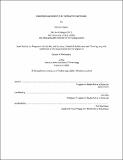| dc.contributor.advisor | Deb Roy. | en_US |
| dc.contributor.author | Saquib, Nazmus | en_US |
| dc.contributor.other | Program in Media Arts and Sciences (Massachusetts Institute of Technology) | en_US |
| dc.date.accessioned | 2021-01-06T20:15:54Z | |
| dc.date.available | 2021-01-06T20:15:54Z | |
| dc.date.copyright | 2020 | en_US |
| dc.date.issued | 2020 | en_US |
| dc.identifier.uri | https://hdl.handle.net/1721.1/129275 | |
| dc.description | Thesis: Ph. D., Massachusetts Institute of Technology, School of Architecture and Planning, Program in Media Arts and Sciences, September, 2020 | en_US |
| dc.description | Cataloged from student-submitted PDF of thesis. | en_US |
| dc.description | Includes bibliographical references (pages 189-197). | en_US |
| dc.description.abstract | The language and formalization of mathematics historically evolved as an interplay between abstractions and their grounding in real world objects and events. The embodied mathematics philosophy posits that our mathematical capabilities are centered around our embodied experiences, and abstract math concepts are layers of metaphors that are based on simple arithmetic capabilities such as categorizing objects, subitizing, and part-whole analysis. Unfortunately, current practice of abstract math often requires us to memorize rules of manipulation, which are cognitively arbitrary, severed from intuitive grounding, and have mechanics and metaphors of their own. While journeying into mathematics, many of us therefore lose the intuitive underpinnings of abstractions. In this dissertation, I develop a design framework and an interactive sketch interface to combine computer algebra algorithms with layers of sketched, visually interpretable compositions. | en_US |
| dc.description.abstract | The framework reimagines some abstract mathematical activities to sketching manipulable structures and performing actions that utilize our natural arithmetic capabilities, enabling the user to form personalized, embodied mathematical representations. The framework solves the challenge of defining a mapping between sketching, iconic objects, symbol algebra, and functions. It converts the symbolic representations of computer algebra to three kinds of sketched primitives and two key interactions. To evaluate the framework and interface, I present examples from the Common Core curriculum, demonstrating how the primitives and the interactions cover a wide range of exercises from Kindergarten to 8th Grade. Qualitative findings from playtesting studies in Bangladesh and USA are then compared to point out the strengths and weaknesses in the design. | en_US |
| dc.description.abstract | An online drawing experiment is also presented that evaluates user preferences for drawing descriptive forms for the proposed mathematical compositions. Next, I describe collaborations with scientists and mathematicians (in astrophysics, neuroscience, and epidemiology) that explore how the proposed methods can reimagine some advanced mathematics, such as numerical integration and differentiation. The ability to do symbol algebra on iconic representations opens up opportunities for doing mathematics with a wide range of physical objects and media. Such affordances are demonstrated through examples. I finish the dissertation by discussing future research opportunities in mathematics, scientific computing, and HCI, and how the landscape of abstract mathematics can adapt embodied mathematics. | en_US |
| dc.description.statementofresponsibility | by Nazmus Saquib. | en_US |
| dc.format.extent | 197 pages | en_US |
| dc.language.iso | eng | en_US |
| dc.publisher | Massachusetts Institute of Technology | en_US |
| dc.rights | MIT theses may be protected by copyright. Please reuse MIT thesis content according to the MIT Libraries Permissions Policy, which is available through the URL provided. | en_US |
| dc.rights.uri | http://dspace.mit.edu/handle/1721.1/7582 | en_US |
| dc.subject | Program in Media Arts and Sciences | en_US |
| dc.title | Embodied mathematics by interactive sketching | en_US |
| dc.type | Thesis | en_US |
| dc.description.degree | Ph. D. | en_US |
| dc.contributor.department | Program in Media Arts and Sciences (Massachusetts Institute of Technology) | en_US |
| dc.identifier.oclc | 1227783727 | en_US |
| dc.description.collection | Ph.D. Massachusetts Institute of Technology, School of Architecture and Planning, Program in Media Arts and Sciences | en_US |
| dspace.imported | 2021-01-06T20:15:53Z | en_US |
| mit.thesis.degree | Doctoral | en_US |
| mit.thesis.department | Media | en_US |
